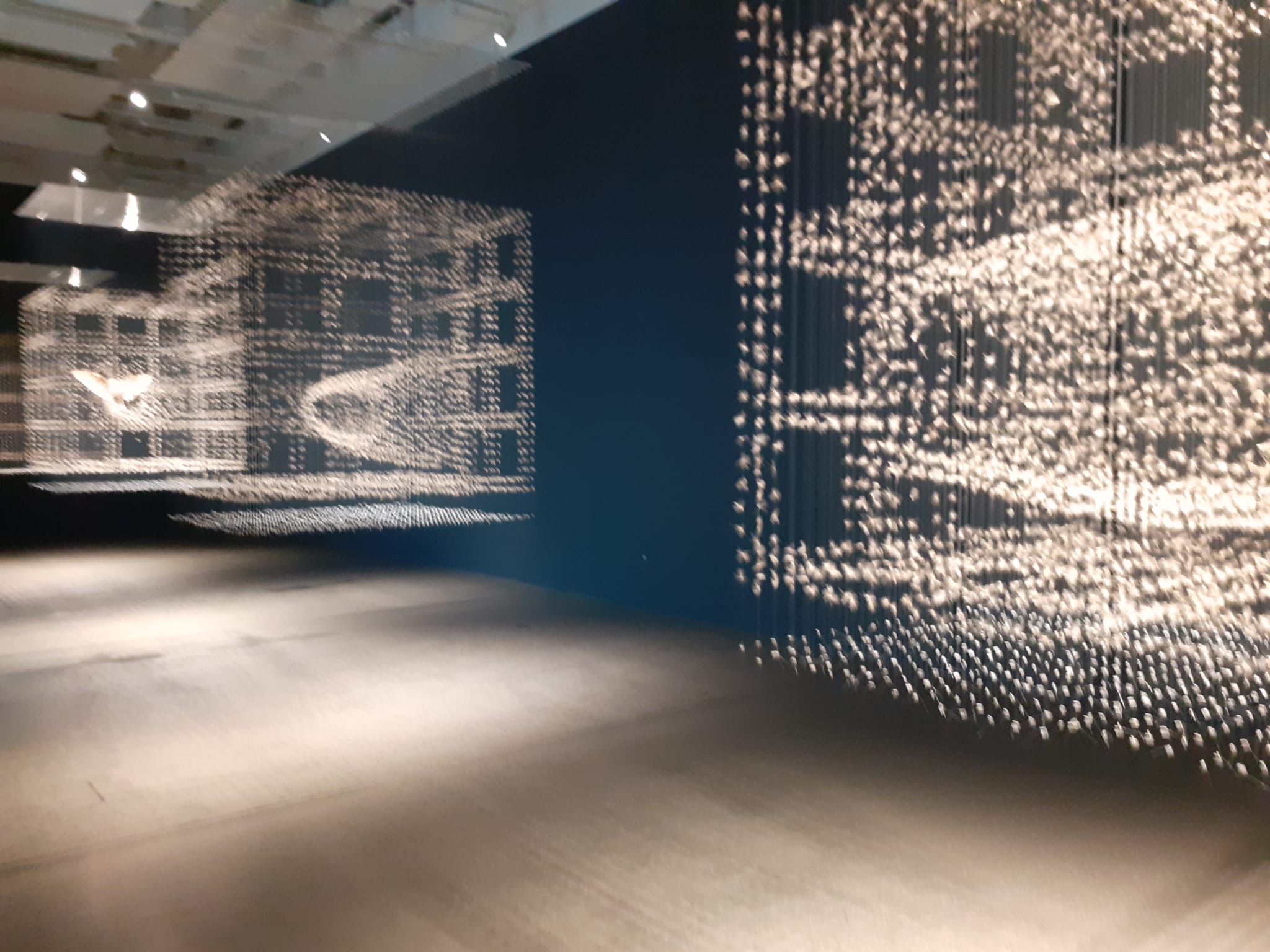
2021
no. 1 "Electric Dance, or How to Talk to Birds” (Johannes Birringer)
no.2 "Anatomy mon Amour" (Johannes Birringer & Michèle Danjoux)
no. 4
Press Release for the Interaktionslabor Manifesto released in September 2014
download here (english) / hier herunterladen (deutsch)
Research Materials for 2021 Performance Academy
Exhibitions
10. Juli 2021 bis 6. Februar 2022
Saarlandmuseum —Moderne Galerie

Claire Morgan, Here is the end of all things, 2011. Installation view. Photo J Birringer © Claire Morgan
Die Moderne Galerie des Saarlandmuseums präsentiert vom 10. Juli 2021 bis 6. Februar 2022 die eindrucksvollen Skulpturen der nordirischen Künstlerin Claire Morgan (*1980). Zwei neue Rauminstallationen in der Ausstellung „Joy in the Pain“ wurden speziell für die Moderne Galerie geschaffen und waren vorher noch nie zu sehen.
Claire Morgans Skulpturen erschüttern unsere Vorstellung von einer Welt,
in der Natur und Kultur getrennt sind. Morgan lässt die Natur in den Kunstkontext
einbrechen, indem sie organisches Material, tote Körper und die Ansammlung
tierischer und pflanzlicher Elemente in eine Ordnung bringt, die als raumfüllende
Kugeln, Kuben oder rechteckige Prismen in einer Art Minimalismus aufgehen.
Diese geometrische Klarheit bricht Morgan durch organische Elemente, die das
Künstliche, Konstruierte mit Leben und Tod durchsetzen: „Ich habe
mich immer dafür interessiert zu erforschen, was wir als Menschen sind:
Unsere tierische Natur und unsere Sterblichkeit, die Beziehung, die wir zu den
anderen Tieren und unserer Umwelt haben,“ so die Künstlerin.
Dabei ordnet sie den präzise an feinen Schnüren aufgereihten Insekten,
Samen oder Polyethylenschnipseln präparierte Tiere zu, wie Füchse,
Eulen, Hasen und Hirsche, Mäuse, Möwen oder auch Schmetterlinge. So
erschafft sie ganz eigene Formen von Still-Leben, die uns die gefährdete
Natur empfindlich nahebringen.
Claire Morgan (*1980 in Belfast /Nordirland) lebt und arbeitet in Gateshead/Großbritannien.
Nach ihrem Kunststudium an der University of Northumbria, UK entwickelte sie
ein aus Installationen, Skulpturen und Zeichnungen bestehendes Werk, das bereits
in zahlreichen Gruppen- und Einzelausstellungen sowohl in Europa als auch in
den USA zu sehen war.
For more into, go here
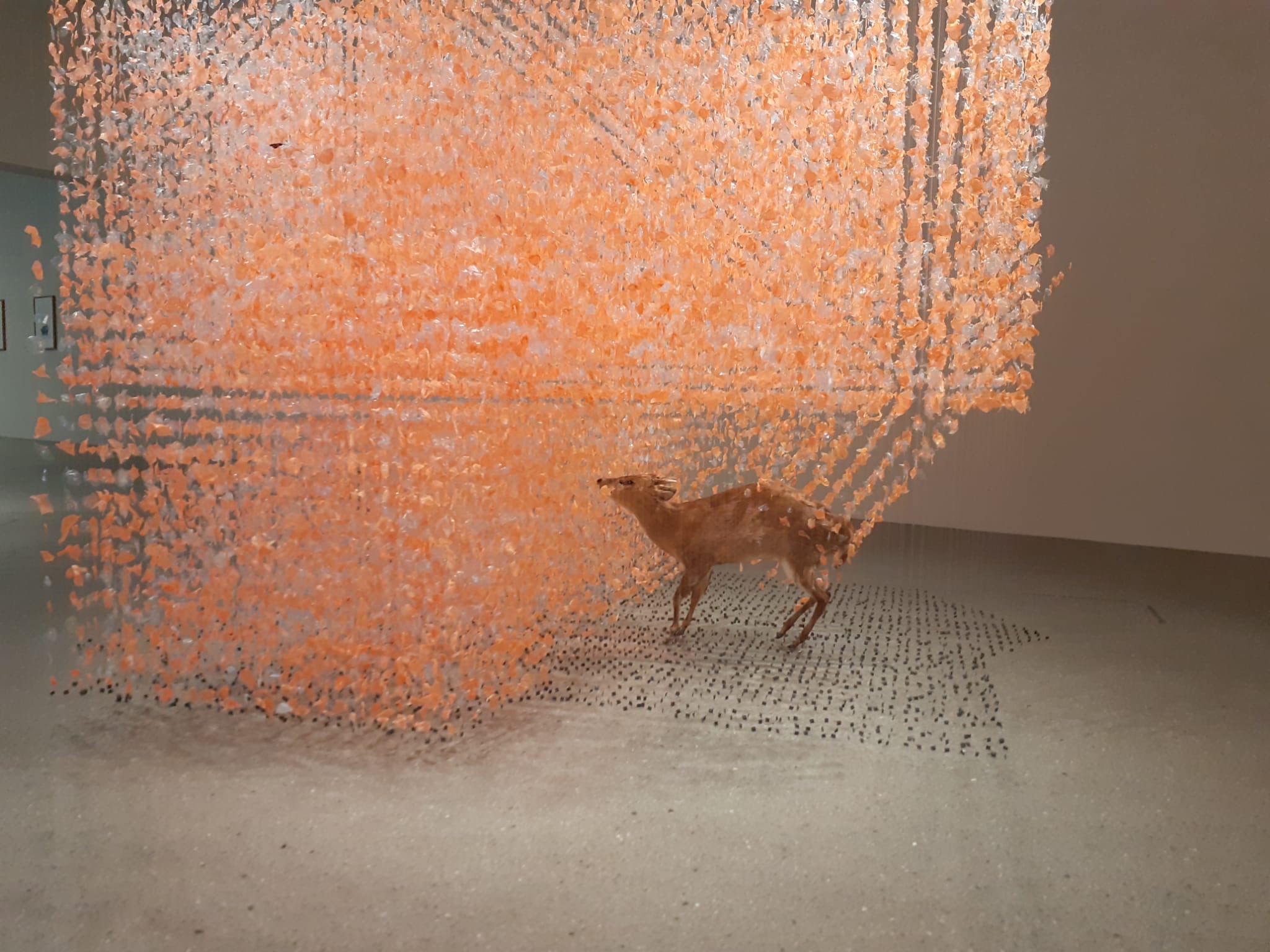
Claire Morgan, If you go down to the woods today, 2014, Muntjakhirsch (Taxidermie), Schmetterlinge, zerrissene Polyethylenfolie, Nylonfaden, Blei. Installation view. Photo: J. Birringer © Claire Morgan
Claire Morgan's sculptures shake the world - more precisely,
our idea of a world in which nature, with its animals and plants, seems to have
just as much a permanent place as man-made objects. Because the separation of
nature and culture no longer works here!
Morgan lets nature leak into the context of art by bringing organic material,
dead bodies and a mass accumulation of animal, insect and plant elements into
an order, which merge as space-filling spheres, cubes or rectangular prisms
in a kind of minimalism.
The artist breaks this supposed geometric clarity with organic elements that
enforce the artificial, the constructed, with life and death:
“In the hanging sculptures there are very precise things - solid bodies,
immutable geometric forms (interacting with animals and nature) - those which
in Nature nowhere really exist. They are made up of huge amounts of small perishable
things - plant seeds, flies, leaves, plastic - to give the illusion of something
solid or concrete. But at the end of the day, they're neither fixed nor concrete,”
said Morgan.
She often assigns a prepared animal (taxidermy) such as foxes, owls, hares,
rabbits, deer and deer, mice, hedgehogs, herons, seagulls, swallows or butterflies
to the precisely lined up insects, seeds and polyethylene snippets. In other
words, animals that live as cultural followers on the threshold (edges) of civilization
and are both present and foreign to us in this environment.
With her rooms and eco-poetic sculptures, Morgan creates a retreat for nature
as a still life that brings us closer to the endangered beauty and fragility
of her fauna. They are frozen moments of calm in which time seems to stand still,
moments that open our eyes to the energy and vitality of a natural environment
and animal nature, the expressiveness of which Claire Morgan captures in her
work. Her work fluctuates between hope and despair over the fact that the natural
world perishes on the artificial one.
Bio
Claire Morgan (* 1980 in Belfast / Northern Ireland) lives and works in Gateshead / Great Britain. She completed her art studies at the University of Northumbria, UK. Since 2003 the artist has been developing a work consisting of installations, sculptures and drawings, which she is constantly developing. Her work has already been shown in numerous group and solo exhibitions both in Europe and in the USA.
* * *
EVA WALKER
PASS ON
Saarländisches Künstlerhaus, Saarbrücken
Exhibition: 15 July - 15 August 2021
Mit der Ausstellung „Pass on“ zeigt Eva Walker erstmals
in größerem Umfang Drucke und Zeichnungen in Saarbrücken. Über
zehn Jahre arbeitete die Künstlerin in Leipzig und ist nun seit Kurzem
zurück in ihrer Heimatstadt.
Die Ausstellung versammelt Arbeiten verschiedener Serien aus
den letzten Jahren und gibt einen Einblick in ihre Arbeitsweise. Die Papierarbeiten
zeigen vielfache Überlagerungen von gedruckten und bezeichneten Schichten.
Große farbige Flächen stehen neben filigran gezogenen Linien. Radierungen
in schwarz und weiß erinnern an vergängliche Kreidezeichnungen auf
einer Tafel. Eine kaum wahrnehmbare Verbindung existiert zwischen den Blättern,
denn Spuren werden im Arbeitsprozess von Blatt zu Blatt weitergetragen und schreiben
Zeitlichkeit in die Bilder ein.
Eva Walker lotet die Möglichkeiten und Grenzen des Materials immer wieder
neu aus. Damit entwickelt sie eine Vielfalt in ihren Arbeiten, die in der Zusammenschau
im Studio des Saarländischen Künstlerhauses eine spannungsvolle Dynamik
entfalten.
2014-2016 Meisterschülerin, Hochschule für Grafik und Buchkunst (HGB)
Leipzig bei Prof. Annette Schröter
2011-2014 Diplom, Studium Malerei/Grafik, HGB Leipzig
2006-2008 Studium Grafik an der Burg Giebichenstein, Hochschule für Kunst
und Design, Halle (Saa-le) bei Prof. Thomas Rug
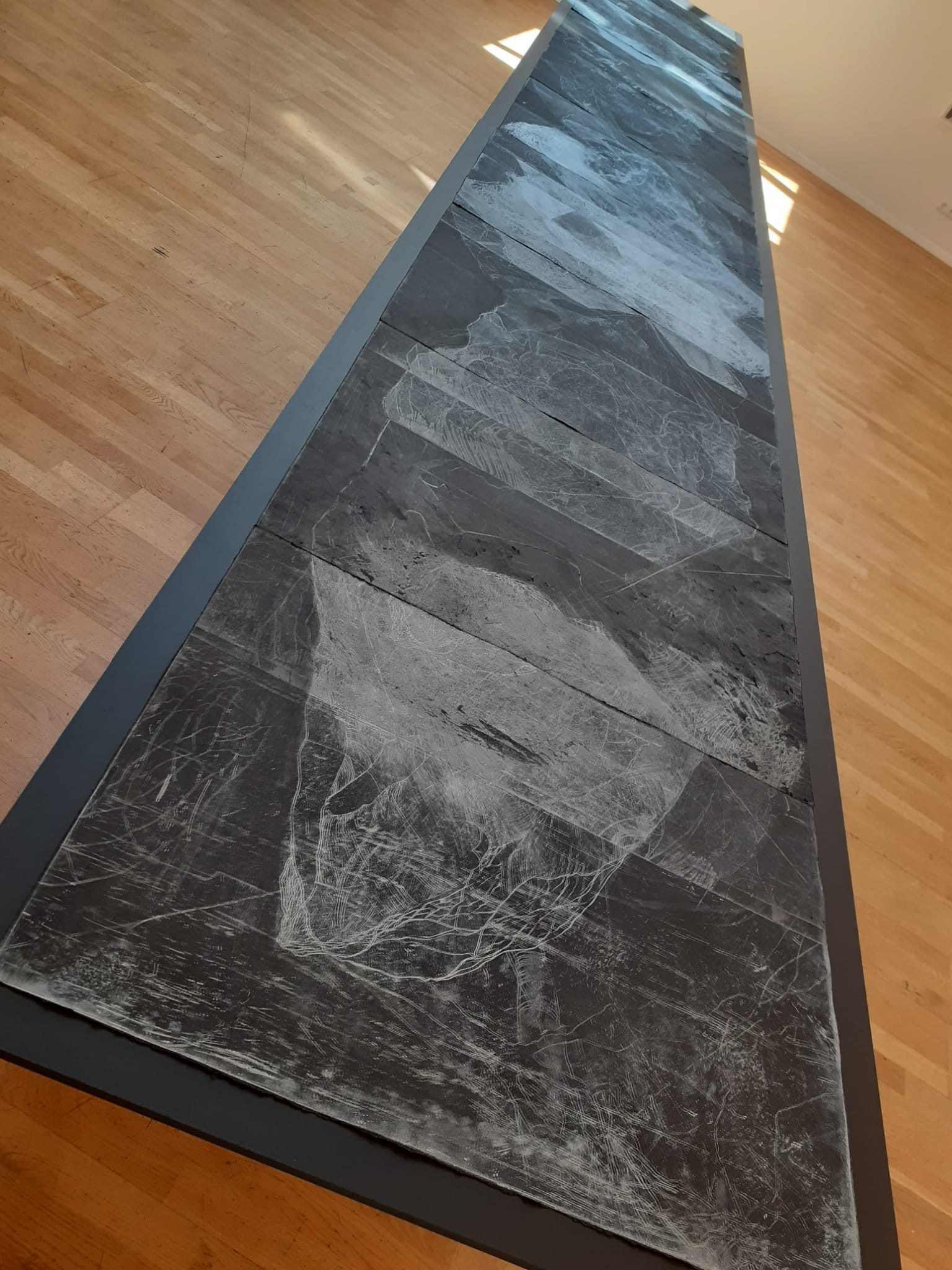
Eva Walker, Pass On, Installation View. Photo: J Birringer, 2021
- - - - - -
Im Studio Blau im Künstlerhaus Keller
Nathalia Grotenhuis
„Die vier Elemente“
10.6. - 15.8.
Die vier Elemente Erde, Feuer, Wasser und Luft gehörten seit der griechischen Antike bis ins 17. und 18. Jahrhundert hinein zu der grundlegenden wissenschaftlichen Erkenntnis des Aufbaus der Natur. Verschiedene Philosophien, theoretische Modelle und Konzepte wurden darauf basierend erstellt.
Nathalia Grotenhuis interessiert vor allem die physikalische Ebene: die Zusammensetzung
und Bedeutung dieser Elemente im Alltag. Jedes Element hat eine eigene physikalische
und atomare Struktur und seine Bedeutung in der Natur. Bemerkenswert ist dabei
die Tatsache, dass die Elemente an sich nicht klingen: Erde klingt erst, wenn
sie aufgewühlt wird; Feuer klingt nicht, nur der zu verbrennende Stoff,
Wind macht kein Geräusch, nur der Gegenstand, der im Wind steht und Wasser
klingt erst, wenn es in Bewegung gerät.
Welche grundlegende Struktur liegt dem Wasser zugrunde? Was ist das Elementare
eines Baumes? Sind die Elemente Feuer, Wasser, Erde, Luft heutzutage durch Bit
und Byte, einem elektrischen Impuls oder dem Atom abgelöst worden?
Nathalia Grotenhuis lebt und arbeitet in Mainz. Dort studierte sie Schlagzeug
und Klang-kunst/Komposition. In ihren künstlerischen Arbeiten geht es nicht
nur um die Vermittlung einer Botschaft über akustische Möglichkeiten,
sondern um eine elementare Möglichkeit, sich in einer Umgebung zurecht
zu finden und mit dieser mit verschiedenen Mitteln zu kommunizieren. Die Wahrnehmung
von Raum, der eigenen Präsenz und die Verbindung zwischen beiden steht
im Mittelpunkt ihrer Arbeiten.
* * *
Staatliche Kunsthalle Karlsruhe, 24/7 – 31/10/2021
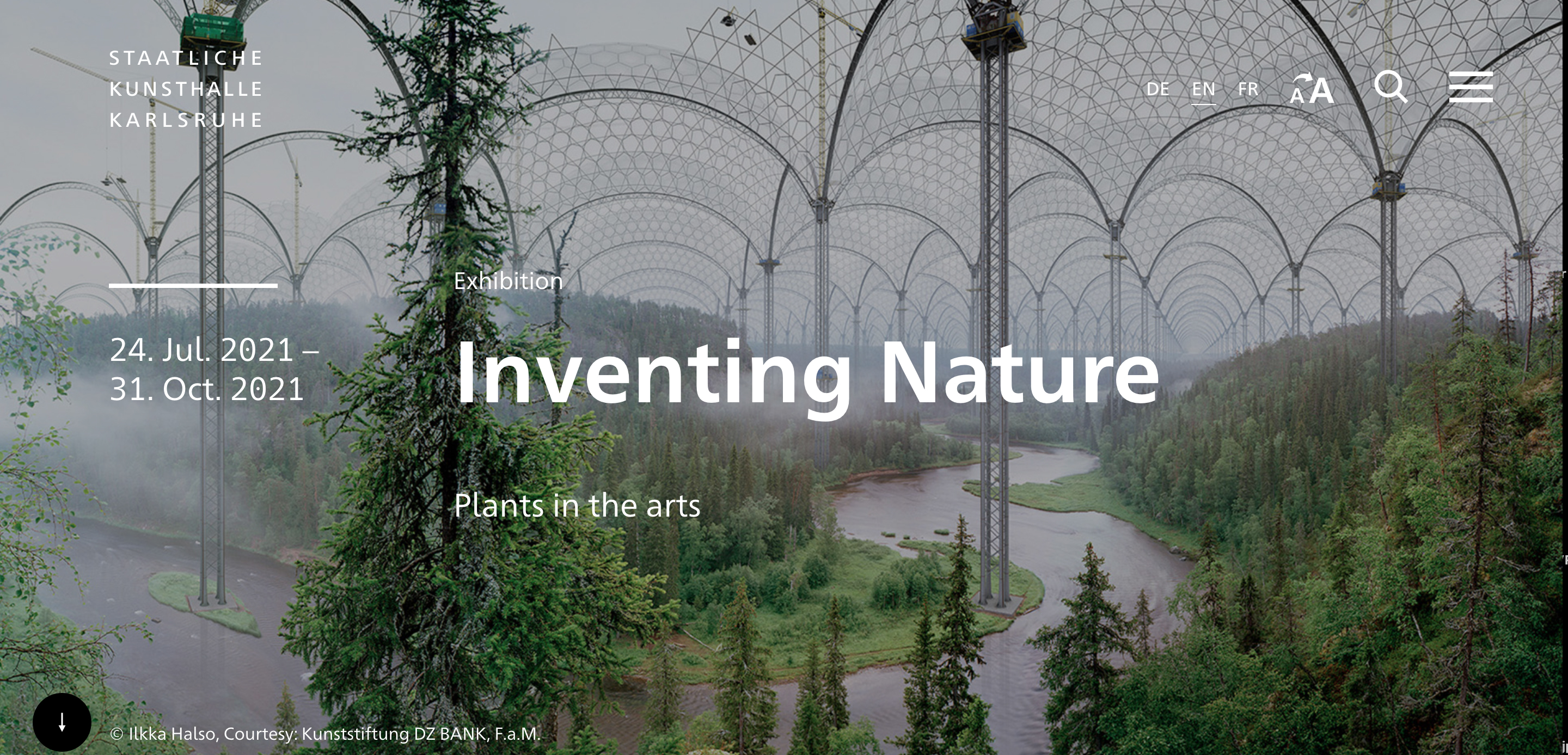
Works from more than 500 years of art history demonstrate the changes in representations
and understanding of “green” nature: Representations of paradise
and wilderness.
Pflanzen
Sie leben und ermöglichen Leben, werden studiert, genutzt, gezüchtet,
geliebt, ¬gesammelt, verwandelt, ausgerottet oder gehegt. Sie können
heilsam sein oder dem Menschen ¬gefährlich werden. Sie sind Material,
das wir ¬¬gestalten, Metaphern, Symbole, Schmuck, Bestandteile einer
speziellen Zeichensprache, Projektionsobjekte unserer Sehnsüchte und Ängste,
Indikatoren ¬unserer ¬geistigen und see¬lischen ¬Verfassung,
schön, schrecklich, eigensinnig und längst nicht vollständig
erforscht. Ganz sicher ¬bergen sie noch frappierende Geheimnisse und raffinierte
Mechanismen, von denen wir lernen können – zu leben, zu ¬kooperieren,
uns zu verwandeln und zu wachsen. Und ebenso sicher lässt sich ein eklatant
wachsendes Interesse und ¬Engagement der Öffentlichkeit konstatieren
angesichts des Diskurses über das »Anthropozän«, also
des jüngst angebrochenen Erdzeitalters, in dem die gesamte Natur –
die ätmosphärischen Prozesse ebenso wie alle anderen von Pflanzen,
Tieren und Anorganischem gebildeten Ökosysteme – von den Aktivitäten
und Hinterlassen¬schaften des Menschen gezeichnet ist. Ausstel¬lung
und Buch zeigen »Erlesenes« aus der Sammlung der Staatlichen Kunsthalle
Karlsruhe und zeitgenös¬sische künstlerische Auseinandersetzungen
mit Vegetabilem. Sie ¬rekonstruieren damit aus kunsthistorischer Sicht unsere
neuzeit¬liche Lektüre im »Buch der Natur«.
Künstler*innen der Sammlung; Willem van Aelst, Silvia Bächli, Ernest
Carrier-Belleuse, Lucas Cranach, Peter Dreher, Max Ernst, Julio González,
Franz William de ¬Hamilton, Hans ¬Holbein, Ferdinand Keller, William
Kentridge, Paul Klee, Wolfgang Laib, Odilon Redon, Jakob van ¬Ruisdael,
Rachel Ruysch, Hanns Schimansky, ¬Johann Wilhelm Schirmer, Liliane Tomasko,
Yves Tanguy u.v.a.
Eingeladen, in einen ¬Dialog mit diesen tradierten ¬Positionen zu treten,
sind u. a. folgende zeitgenössische Künstler*innen: Abbas ¬Akhavan,
Julian Charrière, Simone Demandt, Mark Dion, Spencer Finch, Joan Fontcuberta,
Ilkka Halso, Joan Jonas, Bernd Koberling, Christiane Löhr, Theresa Lükenwerk,
Tobias ¬Rehberger, Martin Schwenk, Julia Schmidt, Kiki Smith, Gerda Steiner
& Jörg ¬Lenzlinger, Robert Voit, Lois Weinberger, Erwin Wurm
* * *
Kunsthalle Baden Baden
17.7.–31.10.2021
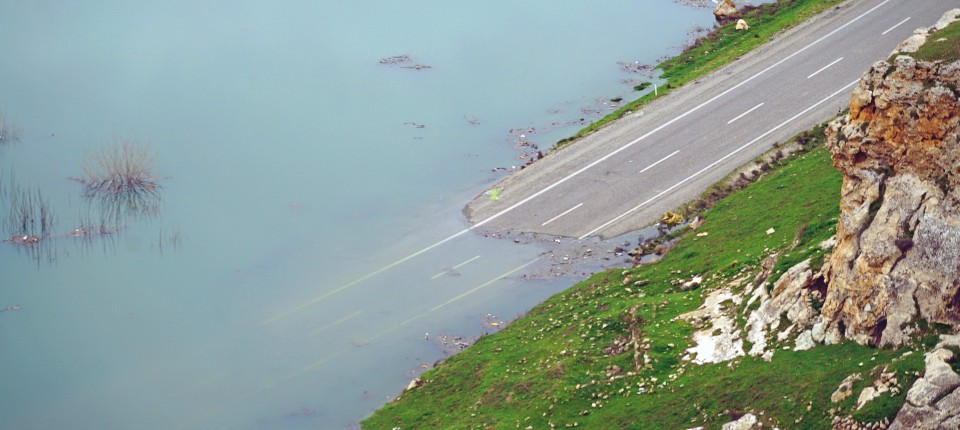
Cengiz Tekins_ Pastorale Sinfonie
Buraya bak¦n, burada, bu kara mermerin alt¦nda
Bir teneffüs daha yas¸asayd¦
Tabiattan tahtaya kalkacak bir çocuk gömülüdür
Devlet dersinde öldürülmüs¸tür.”1)
Ece Ayhan, “Meçhul Ögrenci An¦t¦,” Devlet ve Tabiat
(197)
With newly conceived works and artistic contributions by:
Andreas Achenbach, Sina Ataeian Dena, Khaled Barakeh, Yael Bartana, Mehtap Baydu,
Alfredo Ceibal, Mahmut Celayir, DAF (Dynamische Akustische Forschung), Simone
Demandt, Egemen Demirci & Sunette L. Viljoen, Simon Denny, Silvina Der Meguerditchian,
Nina Fischer & Maroan el Sani, Regina José Galindo, Anike Joyce Sadiq,
Stelios Kallinikou, Henrik Olesen, Alexandra Pirici, Agnieszka Polska, Jimmy
Robert, Robodynamische Diffusion: RDD ( Michael Akstaller, Nele Jäger,
Oliver Mayer, Jan St. Werner ), Gabriel Rossell Santillán, Neda Saeedi,
Cengiz Tekin, Anton Vidokle, Jan St. Werner
State and Nature is the first major exhibition presented by the team under the
new direction at the Staatliche Kunsthalle Baden-Baden. The exhibition departs
from the Kunsthalle’s location and history in the dynamic urban fabric
of the city – between representation, reconstruction, and luxury. Kunsthalle’s
team developed this exhibition under pandemic conditions – in other words,
at a time when structures have become visible and the categories of order and
disorder have been called into question.
Situated in the tapering city park of Lichtentaler Allee, the Kunsthalle Baden-Baden,
as a state-run institution, is an ideal place for enquiry into the changing
relationship between the state and nature -two entities which have a massive
impact on human lives. The exhibition is thus also a critical reflection on
the heritage and reception of the Kunsthalle in relation to the surrounding
nature and an attempt to re-evaluate policies of representation, attributions
of the self and others, and social and economic infrastructures.
Inspired by Ece Ayhan’s anthology of poems Devlet ve Tabiat [State and
Nature] (1973), particularly the above quoted lines from “Monument of
the Unknown Student,” the eponymous exhibition deals with transitions
in the relationships between these two entities. For it is often more than purely
binary: the assumption that nature exists only when it is untouched by humans
or that state power is exercised only between humans, has long ceased to be
true. Ece Ayhan, a native of the Aegean, was a prominent and controversial protagonist
of the so-called I²kinci Yeni movement, which revolutionized Turkish-language
literature. The inspirational power of his writing emancipated poetry’s
capacity to speak about non-privileged people, invisible communities and subtle
gestures. In his work, the state appears not as the force ordering the chaos
of nature but as an unpredictable energy, which people are at the mercy of;
nature, on the other hand, appears as the utopia of lost reason. This political
reading of nature and state also characterises the exhibition.
In particular, the newly commissioned art works and collaborations generated
for State and Nature provide a framework for revisiting these two concepts and
looking at the Kunsthalle’s immediate surroundings through different eyes.
The works call for a new perspective on historical developments of state, citizenship,
and social order, point to limited worldly resources, and ask genealogical questions
about human presence on earth.
The video installation Pastoral Symphony (2021) by Diyarbak¦r-based Kurdish
artist Cengiz Tekin shows the destruction of centuries-old settlement structures
by gigantic dam projects. He asks where the boundary lies between the environment
human beings create and the collapse of nature in currently distressed areas
from Mesopotamia to Central America. Mehtap Baydu’s new sculptural work
has a clear mythological reference to the female ontology of governance: in
S¸ahmaran (2021), the Berlin-based artist with Zazaic roots refers to
the legendary figure from the folk art of Anatolia, Iraq, and Iran, who symbolizes
the vulnerability of nature and female fertility. Her immortality is also an
empowering symbol of female wisdom and resilience.
In the early morning hours of October 4, 2020, Yael Bartana staged her new performance
Days of Awe (2020) on the roof of the Staatliche Kunsthalle Baden-Baden. The
artist transformed this experience into a new film (The Werewolf (WT) (2021)),
which was created for the Kunsthalle and will premiere here. A musician welcomes
the rising sun by blowing several times into a shofar, a musical instrument
made from a ram’s horn, which in Jewish tradition is sounded exclusively
on Yom Kippur. The sound of the shofar was amplified and spread throughout Baden-Baden.
Yael Bartana thus also refers to interconnected aspects of German and Jewish
history, especially in the context of this year’s nationwide celebration
of the anniversary of “1,700 years of Jewish life in Germany.”
Departing from the complex residue of colonial history on the island of Cyprus,
Cypriot artist Stelios Kallinikou’s photographic works Flamingo Theatre
(2015) feature migratory birds and fighter jets thundering through the sky.
They form poetic choreographies and dissolve the supposed opposition between
the state and nature. Through this form of coevality, the British armed forces
and the flamingos that repeatedly congregate on their migratory routes in Cyprus
become agents of a smoldering geopolitics and its consequences for the ecosystem.
In Two Shades of Green (2021), Neda Saeedi directs her artistic gaze towards
a possible future in which architecture and plants are intimately connected.
Her vision of infrastructure enables a coexistence that promotes mutual flourishing,
instead of driving cables and concrete pipes through the living earth and conceiving
of nature and human life as opposites. For her installation, the Iranian artist
collected leaves from walks in Lichtentaler Allee, where numerous plant species
from all over the world have been planted and raised for two centuries and transformed
them into a new kind of herbarium.
Agnieszka Polska’s video The Longing Gaze (2021) connects questions of
relationship and consensus to intimate togetherness, without disregarding the
technologized biopower of global capitalism. The Corona crisis has shown how
sophisticated surveillance apparatuses spy on and record our lives. At the same
time, they have become our only remaining access to the world; a world that
reaches us through digital devices, as our bodies are isolated further from
each other in the face of the virus.
Entitled Synch, there will now be a new space at the Staatliche Kunsthalle Baden-Baden
dedicated to collections, collectives, and creative ideas beyond the temporary
exhibitions. Here, as part of State and Nature, the two-hundred-year-old sketches
and paintings by German painter Andreas Achenbach will meet one of the research
projects supported by the Kunsthalle. Robodynamic Diffusion (RDD) is an innovative
instrument that unfolds sound waves through spatial effects. The sound generated
combines with the imaginary sounds of landscape paintings, seascapes, and other
examples of German Romanticism that augur entropy, disorder, and damage.
The production of new works is funded by the Kulturstiftung des Bundes (German
Federal Cultural Foundation).
State and Nature will be expanded through a discussion, performance, and event
programme with Alexandra Pirici, Regina José Galindo, Mehtap Baydu, and
Denise Ferreira da Silva, among others, which will be announced before the opening
day on www.kunsthalle-baden-baden.de.
State and Nature is co-conceived by the Staatliche Kunsthalle Baden-Baden team.
[1] Parallel to the preparation of the exhibition and accompanying publication,
selected poems by Ece Ayhan will be translated into German for the first time.
This poem has been translated into English by Talat S. Halman, entitled “Monument
of the Unknown Student”:
[…] Look here, underneath this black marble
Is buried a child who would have come to the blackboard
From nature if he had one more breath of life
He was killed in the class on Government
You can download our press kit and image material from www.kunsthalle-baden-baden.de/presse.
For detailed information about the program of the Staatliche Kunsthalle Baden-Baden,
please visit the website.
Press contact
Tel. +49 7221 300 76 414
presse@kunsthalle-baden-baden.de
Staatliche Kunsthalle Baden-Baden
Lichtentaler Allee 8a
76530 Baden-Baden
www.kunsthalle-baden-baden.de
.* * *
OLAFUR ELIASSON:
Fondation Beyeler, Basel, Switzerland
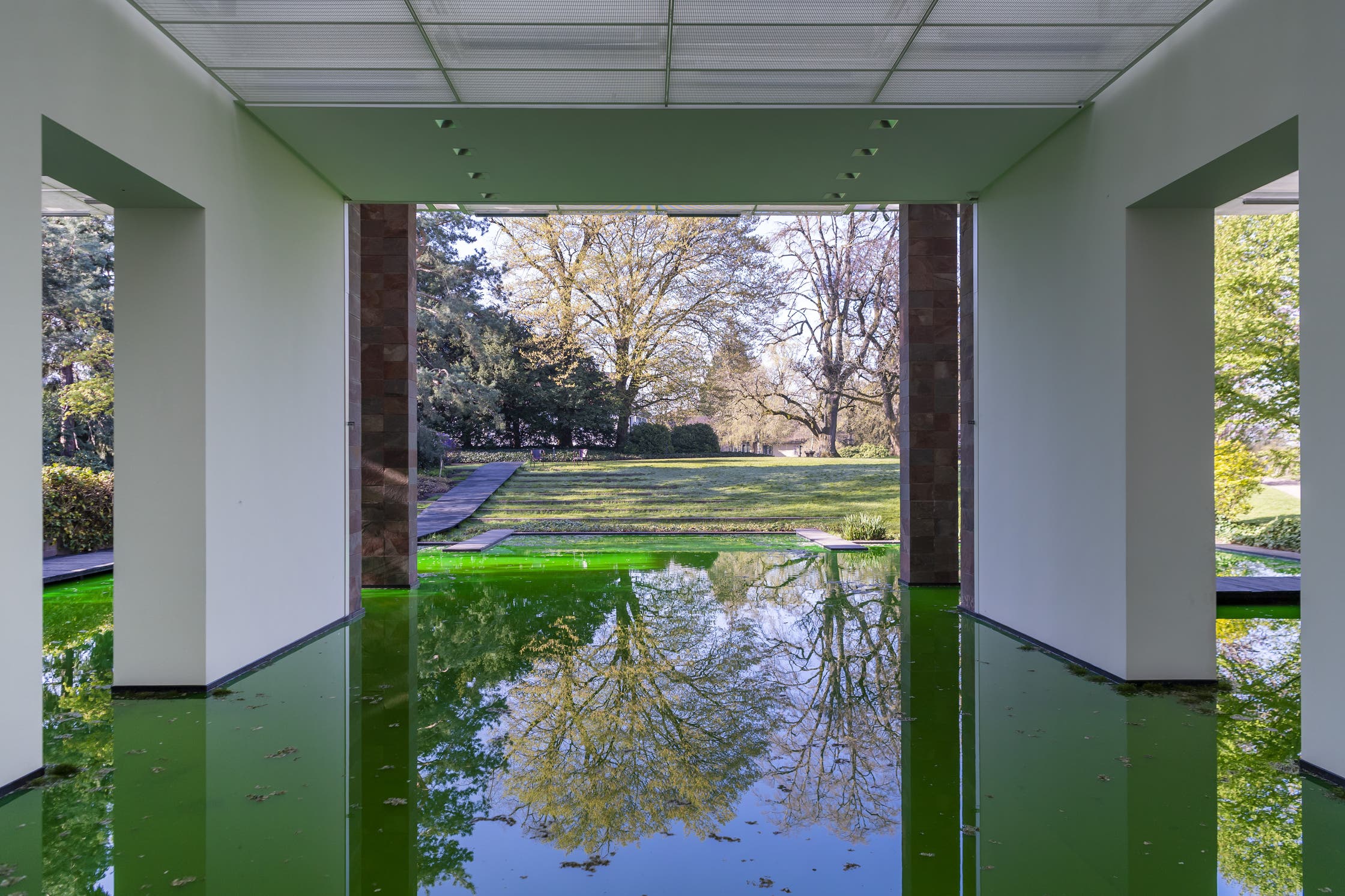
Seit über 25 Jahren erforscht Olafur Eliasson in seinem Werk Fragen der Wahrnehmung, Bewegung, Körpererfahrung und Selbstempfindung. Für ihn ist Kunst ein entscheidendes Mittel, um vom Denken zum Handeln zu gelangen. Eliassons breiter Praxis – Skulptur, Malerei, Fotografie, Film und Installationen – wurden weltweit zahlreiche Ausstellungen gewidmet. Über Museen und Galerien hinaus wendet sich seine künstlerische Arbeit auch an eine breitere Öffentlichkeit, etwa durch architektonische Projekte und Interventionen im öffentlichen Raum. Durch den Einbezug einer Vielzahl von Perspektiven – menschlichen ebenso wie nicht-menschlichen – lädt Eliassons Kunst dazu ein, zukünftige Formen der Koexistenz zu erarbeiten. Für die Fondation Beyeler konzipiert Eliasson ein neues Ausstellungsprojekt, das den Titel «LIFE» trägt. Es ist die erste ortsspezifische Installation des Künstlers in der Schweiz. «LIFE» lädt Besuchende auf eine mit allen Sinnen erlebbare, grenzüberschreitende Erfahrung von Museumsarchitektur und Museumspark ein.
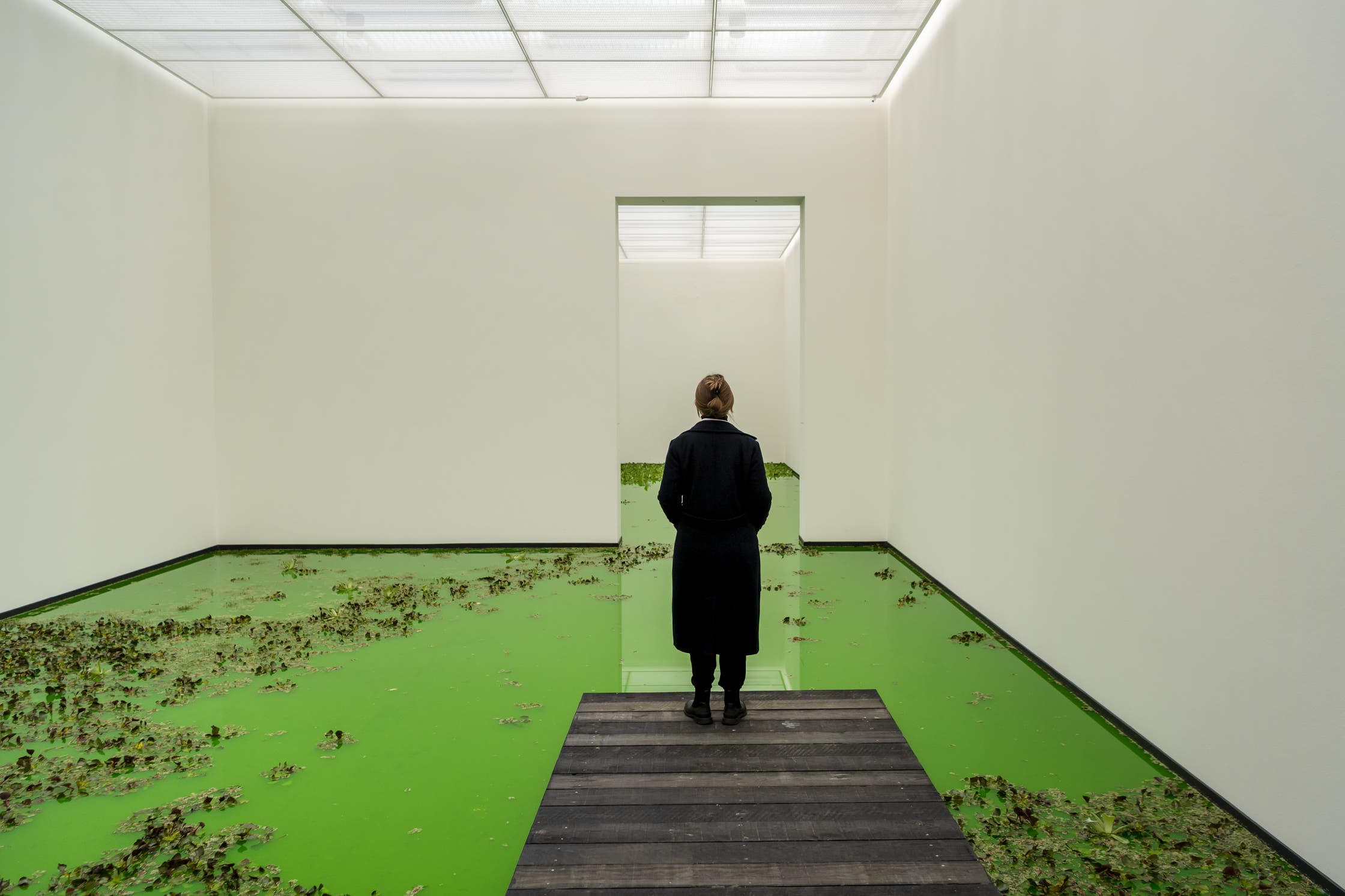
For his current exhibition project "Life" at the Fondation Beyeler
in Riehen (Basel, Switzerland), artist Olafur Eliasson floods half the museum
with water dyed green. On the south side of the museum, all the windows have
been removed so that the adjacent water lily pond now extends into the museum
itself. Visitors can move around the rooms on walkways, and instead of paintings
or sculptures, there are water plants (dwarf water lilies, shellflowers, water
ferns) to see. The bright green water, which takes up most of the space, is
infused with uranine, a nontoxic dye used to study water flow, to make the presence
of the water explicit.? The exhibition runs until July 2021. Life at Night:
https://youtu.be/D_RERJsa2LU Olafur Eliasson: Life. Solo exhibition at Fondation
Beyeler in Riehen (Basel, Switzerland). Press preview, April 14, 2021. Eliasson
refers to "Life" at Fondation Beyeler as a naturalcultural landscape.
The term Natureculture was coined by feminist scientist, historian and author
Donna Haraway. ? ? The artist says, 'Life isn’t about shaping a gloomy
landscape that spells disaster but about presenting a model for a future landscape’.
Eliasson recognizes that for a long time, many people considered humans exceptional
beings, placing ourselves above nature and proposes that now we have to acklowledge
that we humans are little less exceptional than we thought.? ? 'Planetary life
survived at least three billion years before humanity...We need honesty. We
need to be freed from our species-specific arrogance. No evidence exists that
we are chosen, the unique species for which all the others were made. Nor are
we the most important one because we are so numerous, powerful, and dangerous.
Our tenacious illusion of special dispensation belies our true status as upright
mammalian weeds.‘ — Biologist Lynn Margulis
* * *
Zahrah Al Ghamdi
Mycelium Running
Centre Pompidou, Paris
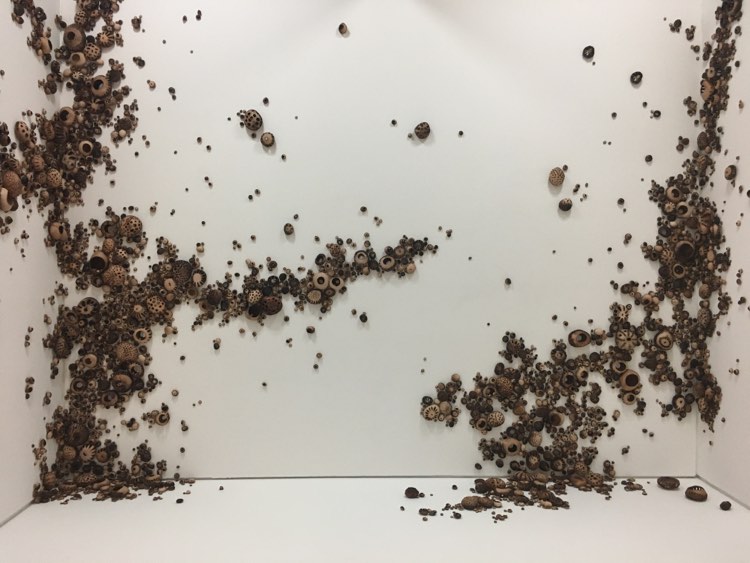
Zahrah Al-Ghamdi’s work explores memory and history through architecture—as a medium in itself and through the actual build. ? ? For this site-specific installation, Al-Ghamdi moulded and formed thousands of leather objects, grouping them together along the wall, floor, and extending out into the courtyard—connecting the internal gallery space to the external natural environment.
Land artist Zahrah Al Ghamdi’s tactile encounters were
initially shown in Venice
(after Saudi Arabia returnded to the Venice Biennale following an eight-year
hiatus with an installation by the Jeddah-based artist)
Jeddah-based artist Zahrah Al Ghamdi’s installation for
the Saudi Arabia Pavilion. Photography: Italo Rondinella. Courtesy of La Biennale
di Venezia involved her spending weeks assembling site-specific works in natural
materials such as sand, rocks and leather. The Jeddah-based artist is part of
an all-female cast who focus on memory, nostalgia, and the tensions between
Saudi traditions and globalisation in their work. An A-lister among regional
collectors, Al Ghamdi also headlines in prestigious venues such as the Jameel
Arts Centre and Alserkal Avenue in Dubai.
In preparation for her Venice Biennale presentation at the Sale d’Armi,
a 15th-century weapons depot, Al Ghamdi spent months cutting, sewing, shredding,
boiling, drying and burning local leather into 52,000 abstract pieces. They
reference random organic forms, Aseeri ornaments and local architecture of Al-Baha,
her birth village in the southwest of the country
Initially entitled After Illusion, the installation is inspired by an ancient Arabic poem by Zuhayr bin Abi¯ Su¯lma¯ (520-609), in which he describes his struggle to recognise his home after being away for 20 years.
Al Ghamdi left Saudi to complete a Masters and a PHD at Coventry
University before returning to Jeddah in 2009, so it’s a sentiment she
understands. Today, her village is almost in ruins.
Leather and cotton reference a childhood spent herding sheep with her grandfather,
and last year, for the annual Shubbak Festival, she created an installation
of lines of sand, dirt and inconspicuous objects sourced her village at the
British Museum. In the 2017 edition of the festival, the artist participated
in the UK’s first all-women show of artists from Saudi Arabia.
The current veersion of Mycelium Running (2019) was presented (before now opening at the Centre Pompidou) at the exhibition 'Second Hand',
* * *
Matthew Barney
Hayward Gallery, Southbank Center, London
July 1- July 25
The artist’s first solo museum presentation in the UK in over a decade, featuring the UK premiere of a new feature-length film.
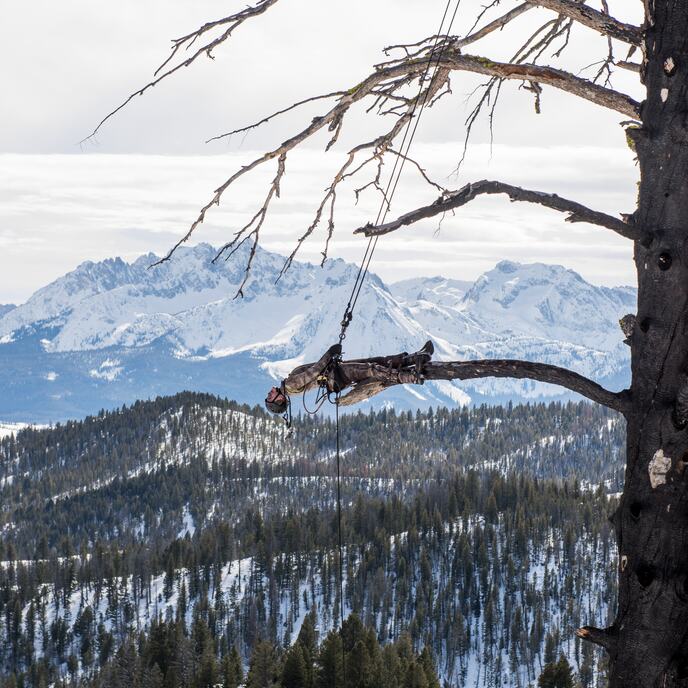
Barney, Redoubt, 2018. Production still. © Matthew Barney, courtesy Gladstone Gallery, New York and Brussels, and Sadie Coles HQ, London. Photo: Hugo Glendinning
The film follows a sharp-shooter in her pursuit of wolves across the winter wilderness of Idaho’s Sawtooth Mountains. She is accompanied by two dancers moving in dialogue. Barney appears in the film as an artist in the employ of the US Forest Service. He tracks and observes the hunter while making a series of copper etchings.
A hoop dance by an indigenous contemporary choreographer is the catalyst for
the wolf hunt’s dramatic conclusion. It uses choreography to weave together
the story of Diana and Actaeon, cosmology and modern American political narratives.
Barney explores the dynamic relationship between humanity and the natural world,
and the role of artistic creation.The etchings featured in the exhibition were
produced on location. The large-scale sculptures are cast from the burnt remains
of trees from the region. Barney combines traditional casting methods and digital
technology to create artworks of formal and material complexity that reflect
on the story told in the film. All hunting scenes in Redoubt were staged using
special effects. Trained animals were provided by professional handlers, who
monitored their safety and the conditions on set. Wild animals were filmed in
their natural habitats.
Teh film, set in Idaho's Sawtooth Mountains, is exhinited with a series of imposing and intricate sculptures, engravings and electroplated copper plates
.
Matthew Barney (b. 1967, lives and works in New York City) is among the most
prominent American artists of his generation. His films and related bodies of
drawing and sculpture have been exhibited internationally for three decades
to wide acclaim. The Cremaster Cycle (1994 – 2002), a series
of five feature-length films that draw on biology, biography and mythology to
explore the process of artistic creation, established Barney's reputation as
an artist and filmmaker of international renown.
This was followed by his operatic film River of Fundament (2014) and
his most recent body of work, Redoubt.
* * *
Tracey Emin / Edvard Munch
18 May — 1 August 2021
Royal Academy of Art
She’s been a major figure in contemporary art for over 25 years; he pioneered
a radical new style known as Expressionism. In this landmark exhibition, Tracey
Emin selects masterpieces by Edvard Munch to show alongside her most recent
paintings.
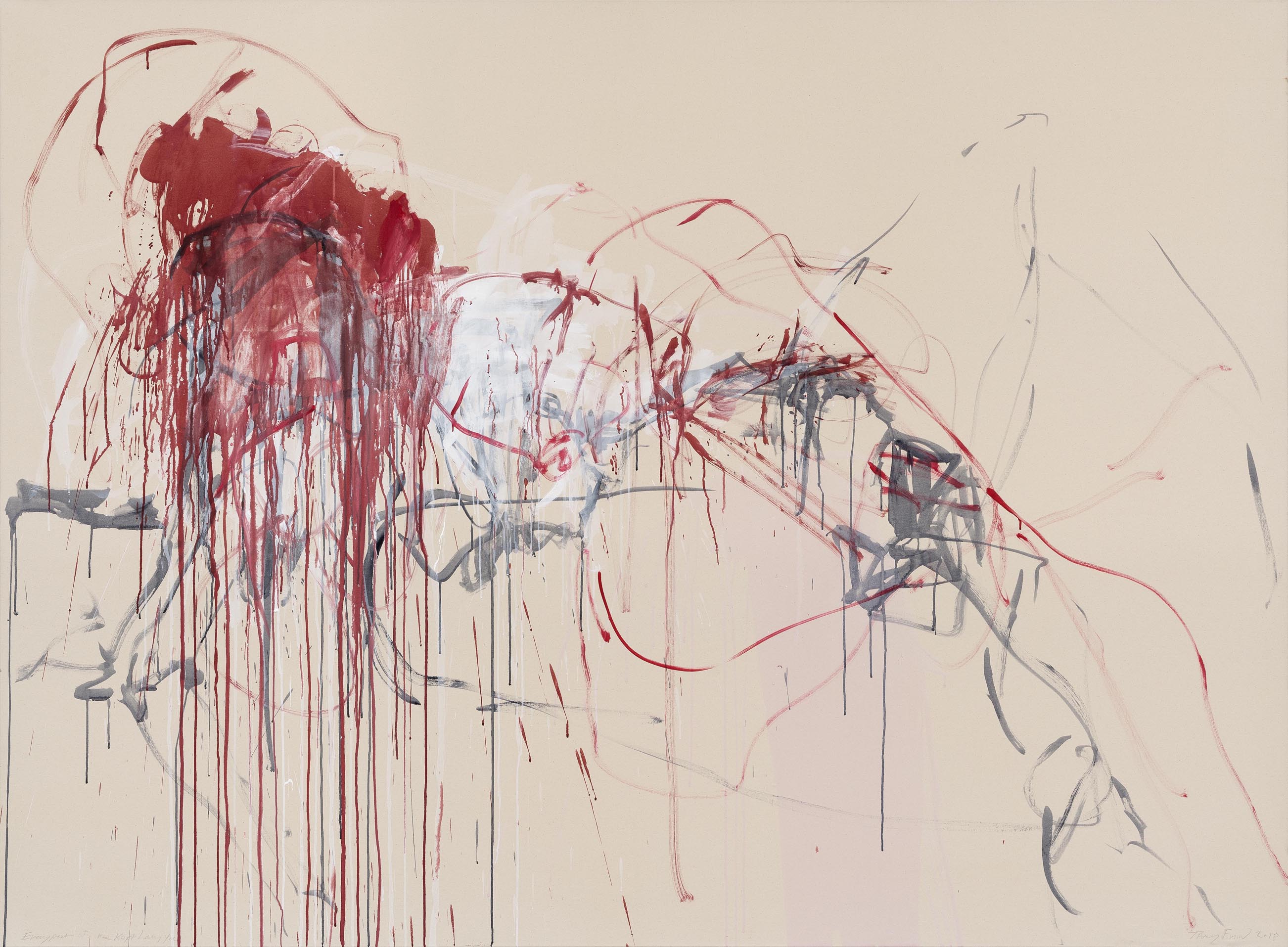
Tracey Emin, Every part of me Kept Loving You, 2018. Acrylic on canvas, 205.7 x 279.5 cm. Private collection, UK © Tracey Emin. All rights reserved, DACS 2020
Tracey Emin has long had a fascination with the Norwegian expressionist and painter of The Scream, Edvard Munch: in her words, “I’ve been in love with this man since I was eighteen”. In 1998 she even created a haunting video piece filmed at the same Oslo jetty that was the location of many of his well-known works. It is just one example of how, like Munch, she embraces even the most painful experiences to create art.
The exhibition features more than 25 of Emin’s works including paintings,
some of which will be on display for the first time, as well neons and sculpture.
These works, which explore the loneliness of the soul, have been chosen by Emin
to sit alongside a carefully considered selection of 18 oils and watercolours
drawn from MUNCH’s rich collection and archives in Oslo, Norway.
This is an opportunity to see Emin’s work in a highly personal show. The
selection reveals not only how Munch has been a constant inspiration –
particularly through his profound portrayals of women – but also showcases
Emin’s wide-ranging skills as an artist, which often interweave painting,
drawing and writing.
Seen together, the dark territories and raw emotions that both artists navigate
will emerge as a moving exploration of grief, loss and longing.
Exhibition organised by MUNCH, Oslo, Norway, in partnership with the Royal Academy
of Arts.
Please note this exhibition contains some adult content.
* * * * *